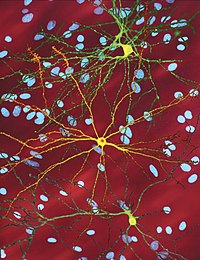
Photo from wikipedia
The mutant huntingtin protein (mHtt) fragments with expanded polyglutamine sequence forms microscopically visible aggregates in neurons, a hallmark of Huntington's disease (HD). The aggregation process and aggregates are possible targets… Click to show full abstract
The mutant huntingtin protein (mHtt) fragments with expanded polyglutamine sequence forms microscopically visible aggregates in neurons, a hallmark of Huntington's disease (HD). The aggregation process and aggregates are possible targets of therapeutic intervention in HD. Owing to the lack of treatment and cure, the patients die within 15–20 years after the disease onset. Therefore, discovering therapeutic molecules that may either inhibit the aggregation mechanism or downregulate the toxic effects of mHtt are highly needed. This study demonstrates the design and use of peptide inhibitors based on the role played by the N‐terminal seventeen amino acid sequence (NT17) of huntingtin fragment in its aggregation. Fug‐NT17 (Fugu), Xen‐NT17 (Xenopus), Dro‐NT17 (Drosophila), Aib‐NT17, and Pro‐NT17 sequences were tested for their ability to inhibit aggregation. Among them, the first three are the sequence variants of human NT17 from evolutionarily distant organisms and the latter two are the analogs of human NT17‐containing aminoisobutyric acid (Aib) and proline (Pro). Four out of five inhibited the aggregation of huntingtin fragment, NT17Q35P10K2 polypeptide. Data indicate that the physicochemical properties of the inhibitors play a crucial role in exhibiting the inhibitory effect. These inhibitors can be tested in cell and animal models for the preclinical evaluation in the treating of HD.
Journal Title: Peptide Science
Year Published: 2017
Link to full text (if available)
Share on Social Media: Sign Up to like & get
recommendations!